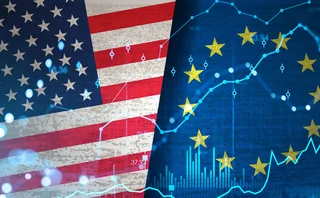(Still) Deconstructing the Flash Crash
As Navinder Sarao fights extradition to the US, a new research report tries to pin down the reason as to why the Flash Crash happened. In the end, though, we still only have theories.

In Australia there is a cold case that has apparently "captivated true-crime fanatics" for nearly 70 years. On December 1, 1948, a man in a suit was discovered, dead, on Somerton Beach in Adelaide.
Tucked in a hidden pocket in his pants was a piece of paper ripped out of a rare book called the Rubáiyát. On the paper was written Tamám Shud, which translates to "The End". Spooky, I know. No one ever has identified the man ─ he's an anomaly ─ but there was a mysterious, secretive woman involved. (Isn't there always?!) Some believe he was a Russian spy. Some believe he was an American spy. Maybe he was just a man. But he was poisoned and left on the beach, and no one has ever been able to figure out why.
It's a fascinating story and I highly recommend you read this piece from The California Sunday Magazine by Graeme Wood about the case. But the point is that sleuths from all over the world have tried to figure out what happened to "the Somerton Man" and why, but all they have is a bunch of theories.
When I finished Wood's feature, I couldn't help but think about the Flash Crash. You know the story: On May 6, 2010, starting at 2:41 p.m. ET, the Dow Jones Industrial Average plummeted nearly 1,000 points. By 2:50, the market had largely recovered...though nerves were severely frayed.
Almost six years later, we still don't know exactly what went down ─ other than the Dow ─ on May 6, 2010. But there are plenty of theories. Some blame mutual fund Waddell & Reed. Some blame high-frequency trading. Some blame fat fingers. Some blame London-based equity futures trader Navinder Singh Sarao. Perhaps it was a combination of all those, and maybe more.
New Theories
On January 25, 2016, two professors from the University of California at Santa Cruz (Eric Aldrich and Gregory Laughlin) and a professor from Stanford (Joseph Grundfest) added their research to the bevy of academic papers that have tried to figure out why the Flash Crash transpired.
As the paper ─ titled "The Flash Crash: A New Deconstruction" ─ notes, it's incredibly difficult to figure out causation because it's not possible to fully reconstruct market events:
The Flash Crash raises difficult, policy-relevant questions of causation. As is the case with most market events, the circumstances of the Flash Crash cannot be replicated. Analysts lack access to the specifications of the automated trading algorithms that were active in the markets prior to and during the crash, and cannot replicate the strategies implemented by human traders active during the relevant period. These limitations are compounded by significant identification issues attributable to complex market interactions and to the simultaneous presence of multiple potentially interactive causal factors. In this environment, correlation is easily confused for causation.
For their research, Aldrich, Grundfest and Laughlin analyzed the full depth of the order book at millisecond granularity. "This level of granularity adds significant computational complexity," they write, "but is, we believe, necessary in the context of a market driven by high-frequency trading and speed-of-light messaging between major market centers."
They also compute order book imbalances at all price levels provided by the CME "and rigorously determine the statistical impact of deep liquidity shifts on subsequent prices for a variety of sample days. Analysis of this sort is necessary in order to study the impact, if any, of the spoofing activity alleged against Sarao."
In addition, they present "a simulation model that explains the evolution of the Flash Crash in a manner consistent with the observable data and that provides insight into conditions that could lead to future flash crashes." And finally, they documented "an anomaly in the time stamps of trades reported to the Consolidated Tape System," which "suggests that increasingly stale prices for the SPY ETF were disseminated to the market and that the inception of this reporting delay correlates strongly with the start of the Flash Crash."
They conclude that the charges against Sarao are probably overblown, which is good for Sarao, who this week is fighting extradition to the United States. And I don't know about you, but I will sleep better believing that a small-time trader in London can't bring down the Dow with a flurry of spoofing orders.
So What Was It?
Aldrich, Grundfest and Laughlin's ultimate findings are consistent with the analysis provided by the Joint CFTC-SEC Staff Report on the Flash Crash:
[W]e find that the Flash Crash is sufficiently explained as the result of the confluence of the unsettled market conditions that prevailed in the hours leading up to the Flash Crash combined with the size and execution strategy of the Waddell & Reed trades. We confirm that offer-side order book imbalances increased substantially in the hour immediately prior to the crash, but only at price levels deep in the book. ... we are conducting further analyses to determine whether the anomalies in the off-exchange trades that were reported to FINRA are better viewed as symptoms of a rapidly moving market, or as causal factors.
And should we expect more "Flash Crashes" in the future? Maybe...
Our simulation model suggests that the probability of recurrence of a Flash Crash can be described as a function of the ratio of high-frequency, liquidity-consuming traders to fundamental, non-HFT traders.
While not nearly as riveting a read as Graeme Wood's "Somerton Man" feature, it's interesting, nonetheless, and delves deep into the data underpinning the Crash. But the unfortunate thing is that we still don't fully know if the Flash Crash points to something systemic in the market, or if it was merely an anomaly.
I can't help but think, though, that advancements in machine learning could help in the future to serve almost like an earthquake warning for spikes in the market, where there's a warning for growing imbalances or messaging spikes that could trigger future crashes? Or maybe I'm putting way too much faith in machine learning.
Got your own theories? Let me know them: anthony.malakian@incisivemedia.com
Only users who have a paid subscription or are part of a corporate subscription are able to print or copy content.
To access these options, along with all other subscription benefits, please contact info@waterstechnology.com or view our subscription options here: https://subscriptions.waterstechnology.com/subscribe
You are currently unable to print this content. Please contact info@waterstechnology.com to find out more.
You are currently unable to copy this content. Please contact info@waterstechnology.com to find out more.
Copyright Infopro Digital Limited. All rights reserved.
As outlined in our terms and conditions, https://www.infopro-digital.com/terms-and-conditions/subscriptions/ (point 2.4), printing is limited to a single copy.
If you would like to purchase additional rights please email info@waterstechnology.com
Copyright Infopro Digital Limited. All rights reserved.
You may share this content using our article tools. As outlined in our terms and conditions, https://www.infopro-digital.com/terms-and-conditions/subscriptions/ (clause 2.4), an Authorised User may only make one copy of the materials for their own personal use. You must also comply with the restrictions in clause 2.5.
If you would like to purchase additional rights please email info@waterstechnology.com
More on Regulation
Risk managers question US reach of Dora third-party list
Some EU subsidiaries included, but regulator control over cloud providers could still be limited.
Where have four years of Cusip legal drama gone?
The IMD Wrap: The antitrust case against Cusip Global Services has been a long, winding road. Reb recaps what you might have missed.
2026 will be the year agent armies awaken
Waters Wrap: Several AI experts have recently said that the next 12 months will see significant progress for agentic AI. Are capital markets firms ready for this shift from generative AI to agents?
Despite regulatory thaw in US, major questions remain globally for 2026
From crypto and tokenization to the CAT to consolidated tapes to T+1’s advancement, the regulatory space will be front and center in the New Year.
Will overnight trading in equity markets expand next year? It’s complicated.
The potential for expanded overnight trading in US equity markets sparked debate this year, whether people liked it or not.
Waters Wavelength Ep. 342: LexisNexis Risk Solutions’ Sophie Lagouanelle
This week, Sophie Lagouanelle, chief product officer for financial crime compliance at LNRS, joins the podcast to discuss trends in the space moving into 2026.
Citadel Securities, BlackRock, Nasdaq mull tokenized equities’ impact on regulations
An SEC panel of broker-dealers, market-makers and crypto specialists debated the ramifications of a future with tokenized equities.
FIX Trading Community recommends data practices for European CTs
The industry association has published practices and workflows using FIX messaging standards for the upcoming EU consolidated tapes.








